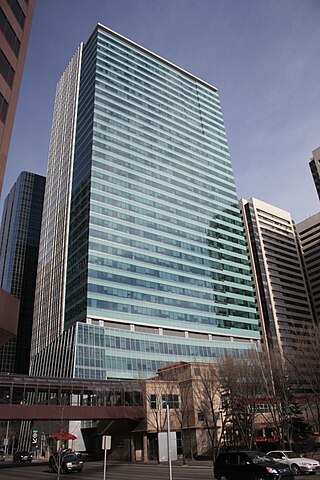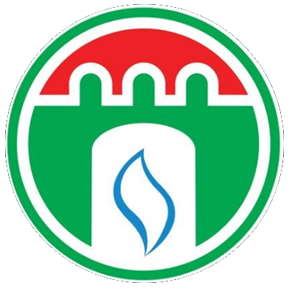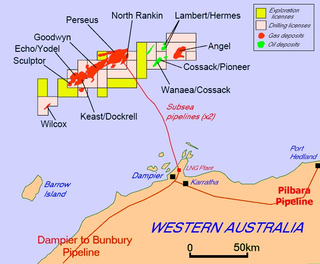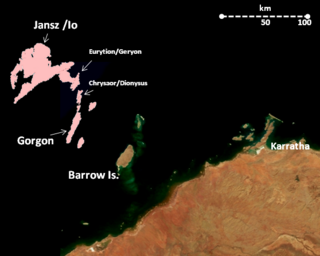
Liquefied natural gas (LNG) is natural gas (predominantly methane, CH4, with some mixture of ethane, C2H6) that has been cooled down to liquid form for ease and safety of non-pressurized storage or transport. It takes up about 1/600th the volume of natural gas in the gaseous state (at standard conditions for temperature and pressure).

TC Energy Corporation is a major North American energy company, based in the TC Energy Tower building in Calgary, Alberta, Canada, that develops and operates energy infrastructure in Canada, the United States, and Mexico. The company operates three core businesses: Natural Gas Pipelines, Liquids Pipelines and Energy.
The Sakhalin-2 project is an oil and gas development in Sakhalin Island, Russia. It includes development of the Piltun-Astokhskoye oil field and the Lunskoye natural gas field offshore Sakhalin Island in the Okhotsk Sea, and associated infrastructure onshore. The project is managed and operated by Sakhalin Energy Investment Company Ltd..

Kitimat is a district municipality in the North Coast region of British Columbia, Canada. It is a member municipality of the Regional District of Kitimat–Stikine regional government. The Kitimat Valley is part of the most populous urban district in northwest British Columbia, which includes Terrace to the north along the Skeena River Valley. The city was planned and built by the Aluminum Company of Canada (Alcan) during the 1950s. Its post office was approved on 6 June 1952.
Elba Island is an island in the Savannah River, near the US port city of Savannah, Georgia on the Atlantic Ocean. It functions as an import and export facility for liquefied natural gas. The island lies five miles downstream from the city of Savannah, and is part of Chatham County, Georgia. Its name comes from the Mediterranean island of Elba.

Douglas Channel is one of the principal inlets of the British Columbia Coast. Its official length from the head of Kitimat Arm, where the aluminum smelter town of Kitimat to Wright Sound, on the Inside Passage ferry route, is 90 km (56 mi). The actual length of the fjord's waterway includes waters between there and the open waters of the Hecate Strait outside the coastal archipelago, comprising another 60 km (37 mi) for 140 km (87 mi)in total.
The Haisla Nation is the Indian Act-mandated band government which nominally represents the Haisla people in the North Coast region of the Canadian province of British Columbia, centred on the reserve community of Kitamaat Village. The traditional territory of the Haisla people is situated along the Douglas Channel Region of Kitimat on British Columbia’s north coast, and includes the Kitlope Valley which is rich in natural resources, especially salmon.

Cove Point LNG Terminal is an offshore liquid natural gas shipping terminal operated by BHE GT&S, a Berkshire Hathaway Energy company. It is located near Lusby, Maryland, United States, on the western shore of the Chesapeake Bay, and exports liquefied natural gas (LNG) and also stores gas. LNG is exported on specially designed ships known as LNG carriers.
Persian LNG is the LNG project in Iran. It has been defined based on the reserves of the South Pars gas field. The project is developed by the National Iranian Gas Export Company.

GAIL (India) Limited is a central public sector undertaking under the ownership of the Ministry of Petroleum and Natural Gas, Government of India. It has the following business segments: natural gas, liquid hydrocarbon, liquefied petroleum gas transmission, petrochemical, city gas distribution, renewable Energy including Solar & Wind, exploration and production, Petrochemicals, GAILTEL and electricity generation. GAIL was given the MahaRatna status on 1 Feb 2013 by the Government of India. Only 11 other Public Sector Undertakings (PSUs) enjoy this coveted status amongst all Central PSUs.

Yemen LNG is the first natural gas liquefaction (LNG) project in Yemen. The LNG plant is located in Balhaf.

Oman LNG is a LNG plant in Qalhat near Sur, Oman. The company was established by the Royal decree of Sultan Qaboos of Oman in 1994. The construction was launched in November 1996, and the plant was commissioned in September 2000. Oman LNG operates three LNG trains with a total capacity of 10.4 million tonnes per year. The company's production facilities are located on the coast at Qalhat near Sur in the South Sharqiyah Governorate, Oman.
Malaysia LNG (MLNG) is a liquefied natural gas manufacturer in Malaysia. It operates in the 9 liquefaction modules PETRONAS LNG Complex, Bintulu, Sarawak. In 2007, it was the largest LNG manufacturing complex. Currently, top 5 largest LNG plant in the world as of 2022.
SEGAS LNG is a liquefied natural gas (LNG) complex in Damietta, Egypt. It is located 60 kilometres (37 mi) west of Port Said. The name SEGAS comes from the Spanish Egyptian Gas Company. The complex consists of a single LNG train capable of liquifying up to 5 million tons of natural gas per year and is one of two LNG export plants in Egypt.

The North West Shelf Venture, situated in the north-west of Western Australia, is Australia's largest resource development project. It involves the extraction of petroleum at offshore production platforms, onshore processing and export of liquefied natural gas, and production of natural gas for industrial, commercial and domestic use within the state.

The Gorgon gas project is a multi-decade natural gas project in Western Australia, involving the development of the Greater Gorgon gas fields, subsea gas-gathering infrastructure, and a liquefied natural gas (LNG) plant on Barrow Island. The project also includes a domestic gas component. Construction was completed in 2017.
Natural gas was Canada's third largest source of energy production in 2018, representing 22.3% of all energy produced from fuels in the country. By contrast, the share of fuel-based energy production from natural gas in 2013 was 17.0%, indicating a growth rate of approximately 1.06% per year.


Costa Azul LNG is a sea port and natural gas processing center, located 15 miles north of Ensenada, Baja California, Mexico. Opened in 2008, the terminal can process up to one billion cubic feet of natural gas per day. This is the first liquefied natural gas (LNG) terminal on the North America west coast. LNG carrier ships capable of holding up to 220,000m3 of LNG can dock in the deep water port off the coast to unload LNG. The natural gas from the terminal is used to produce electricity and is fed by pipe lines to factories. The longest pipeline runs north, to the United States. Sempra Energy is a partner in the port with PEMEX. The LNG ship Al Safliya was the first ship to port and unload at Costa Azul. The Al Safliya is a 210,000 cubic meter LNG ship, its LNG was from Qatar. The other Mexican LNG Terminal in the Pacific Ocean is at Manzanillo, Colima, the Manzanillo LNG Terminal.















